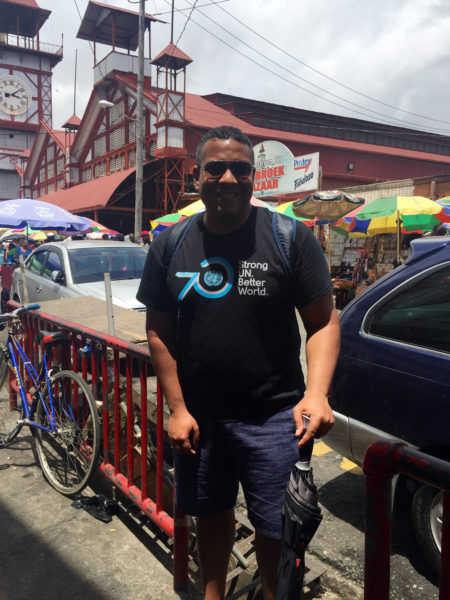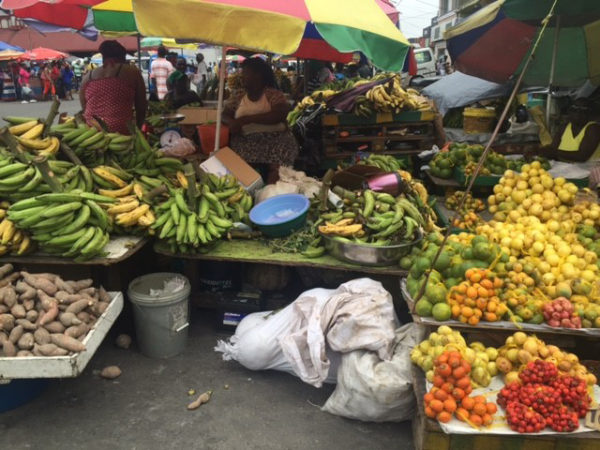By Matthew Wilson
It was in March 1999, only a few months after I had joined the Barbados Foreign Service, that I took my first professional trip abroad. Since then, 17 years have passed, hundreds of work trips have been completed and I’ve not only changed jobs but changed countries. But that first trip remains vivid in my mind. It was to Guyana.
I had my red diplomatic passport in hand and all of my family came to the airport in Barbados to see me off. All of the family. And my late grandmother handed me a brown paper-wrapped package tied with a piece of string containing six ham sandwiches. ‘This is if you get hungry when you land,’ she said.
When I arrived into Georgetown it was a rainy Sunday evening. The shops were closed and there were few people around. I went back to my hotel – the famous Pegasus Hotel – and ate my ham sandwiches. Moral of the story? Your grandmother is really always right.
Guyana struck me as a place stuck in time. It did not feel Caribbean at all but rather quite disconnected from the rest of the region.

Seventeen years later I was on a flight back to Guyana. By this time I had done my decade plus in the Barbados diplomatic corps representing the country – and often the region – at the trade negotiations at the World Trade Organisation in Geneva, Switzerland. I had joined the WTO and served as the first Caribbean person in a Director General’s Cabinet, and now as the Chief of Staff to Arancha Gonzalez, the Executive Director of the International Trade Centre, a development agency of the United Nations and the WTO, I was accompanying her to Guyana to address Caribbean Trade Ministers and to launch a coconuts value chain project for Guyana and a number of other Caribbean countries.
In the intervening period I had become a real advocate for Guyana. The foreign service of Guyana in the 1970s and 1980s was the story of Caribbean legend and Guyana was always spoken of a as country just on the cusp. Just on the cusp of becoming a regional powerhouse because of its geo-location. Just on the cusp of being the Caribbean’s bread basket. Always just on the cusp.
The Caribbean as a region is going through some difficult times and Guyana is no exception. The regional integration movement has essentially stalled, our diplomatic footprint is less deep than it was a decade ago, economic growth is low, tourism is down and regional unemployment is increasing. But it was the possibilities that I was interested in. Strategic geographic location, well educated population, under-exploited natural resources, youthful and innovative societies and tangible economic opportunities in the areas of services, bespoke tourism products and agro-processing. Guyana has all of these in droves and more.
Landing at the Cheddi Jagan International Airport I was greeted with warm light showers and a steel pan playing in the arrivals. The taxi ride to Georgetown was a spectacle of uniformed school children, beautiful houses, lots of green fields and agricultural land. The whole place actually looked and smelt alive and vivid. Yes, the traffic was bad but from every direction there was something happening. This was no longer the sleepy place of almost two decades ago.
I was completely taken aback by the beauty of the architecture. Like Miss Havisham’s Satis House in Charles Dickens’s novel Great Expectations, Georgetown was a place of crumbling beauty. Never had I seen such amazing buildings in such proximity than I did on High Street and Main Street. It was an architecture lover’s dream with the wooden colonial buildings with their beautiful sleepy window shades and tall gables some with distinctive spires and massive wooden doors. Entering the St George’s Cathedral, with its warm and welcoming custodian who spent ten minutes telling me about her love for fried fish at Oistins Fish market in Barbados, was a real moment. With its polished wooden interior and bright pink and yellow stained glass windows, the church which is allegedly the tallest wooden structure in the hemisphere, was as impressive to me in its own special way as the Notre Dame in Paris or St Paul’s Cathedral in London. Like the wooden Immaculate Conception Church in Castries in St Lucia, this was a church made of and for the Caribbean. I had similar experiences seeing the Parliament Buildings, the Georgetown City Hall and the National Library which are all beautiful old buildings telling the story of the country.
My personal highlight however has to be reserved for Stabroek Market. I’ve been to many markets in my travels. Markets are the heart of a country. This is where you see what a country produces from the land and where the core of a country’s personality often resides in its colourful characters, sights, sounds and smells. Stabroek Market was an exceptional insight into Guyana. Heaving stalls of naturally organic fruit and vegetables, fresh fish of all kinds, homemade bottled wine and punches, roadside carts filled with sweet buns, spices and seasonings – it was a potpourri of Caribbean life encased within a stunning red building with its imposing clock tower.

What I was most struck by was the produce. Guyana with its vast farming land is a shockingly under-utilised source of goods for the Caribbean and beyond. There is no shame in agriculture and this is a message that the region as a whole needs to better acknowledge. Moving amongst the vast bags of potatoes, plump red tomatoes, massive soursops, pungent onions and all forms of colours and shapes I bemoaned the fact that I could not even get a fresh fruit juice at my hotel. Where were these fruit and vegetables on my menu? Why was there no push to get local produce onto the tables in hotels and restaurants in Guyana and the wider region?
The reasons for this are varied and sometimes complex. The aforementioned view that agriculture is an archaic sector is one such reason but beyond that it is about lack of sustainable value chains to link the agro-processing and tourism sectors and limited capacity to meet the standards needed to export.
And this is where an organisation like the International Trade Centre (ITC) is trying to assist. ITC, with its partner the Caribbean Agricultural Research and Development Institute (CARDI) and with the support of the European Union is working to bring the coconuts sector back to life in Guyana and in a series of other Caribbean countries by working to connect supply and demand in international markets, to provide assistance on meeting international regulatory standards, and to explore innovative ways of helping Caribbean coconut producers be part of an industry that is expected to reach US$4 billion by 2019. But coconuts is just one such value chain that ITC can help the Caribbean on. Pepper sauces in Barbados, black pineapple in Antigua, cassava in St Vincent and the Grenadines, coffee in Jamaica, nutmeg in Grenada, jackfruit in Guyana – the options are endless when one sees the growing international demand for the agricultural products and their derivatives which grow just about anywhere in the region.
Guyana, with its excellent and warm services culture, its architecture, its agriculture potential and not to mention the unvarnished tourism opportunities in the interior, can be a serious regional player. It won’t take another two decades until I return. I hope to be there later this year to celebrate the inaugural coconut festival and to continue to see how this country can continue to develop and exploit its potential. Maybe this time I may even bring some ham sandwiches.
Matthew Wilson, a Barbadian National, is the Chief of Staff at the United Nations International Trade Centre (ITC)




